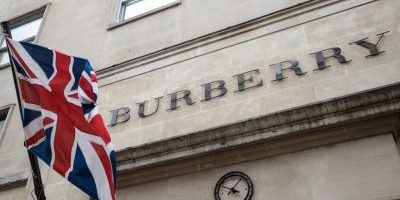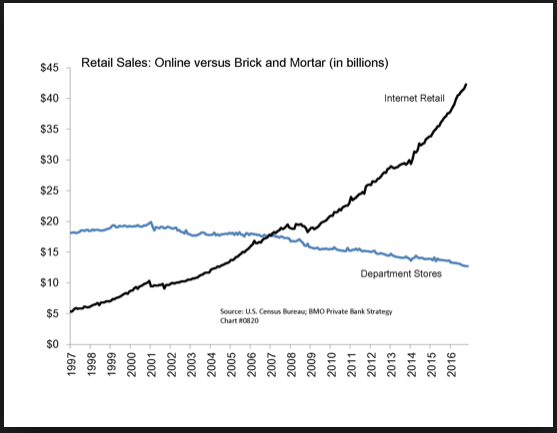Pretty in Plaid? Burberry’s Hits and Misses with Machine Learning

Image Credit: (Photo by Jack Taylor/Getty Images).
Retail is not typically the industry that comes to mind when implementing new technologies—high fashion and big tech typically do not mix. But through the use of machine learning, Burberry is revolutionizing this notion to improve its in-store customer experience. The question remains, however, whether it will continue this trend in other aspects of their business.
Retail is dead. Or is it?
Charts such as this one by the U.S. Census Bureau created a streak of panic throughout the retail world, which led to the frequently repeated assertion that retail is dead. As the overall trend of shopping at brick and mortar stores declined and e-commerce grew, online shopping emerged as a much more attractive option for consumers looking to battle inconveniences such as parking, crowds and stock availability [1].
These doomsayers claimed that e-commerce posed an existential threat to traditional retail stores. True or not, shifting customer preferences have led many retail brands to rethink how they approach their customer experiences both online and in-store, and luxury brands are no exception [2].
The question facing retail today is how to enrich the overall customer experience and add value beyond simply providing merchandise. Successful retailers are interested in a mindset shift from being mere sellers to true purveyors of experience [3].
USING MACHINE LEARNING TO IMPROVE CUSTOMER IN-STORE EXPERIENCE
Fashion powerhouse Burberry found the answer to enriching customers experiences in the form of machine learning. The company is using this technology in innovative ways as part of its overall strategy for increasing sales. Moreover, they are making the shopping experience at their brick-and-mortar stores just as advanced as their online experience [4].
Its unique machine learning model asks customers “to voluntarily share data through a number of loyalty and reward programs. This information is then used to offer personalized recommendations, both online and in-store. When an identified customer enters a store, sales assistants use tablets to offer buying suggestions based on their customers’ purchase history as well as their social media activity. If Burberry knows that a customer has recently bought a particular coat, for example, assistants may then be encouraged by the app to show them a handbag which is popular with other buyers of the coat” [5].
This type of highly personalized shopping experience is usually confined to an online retail space [6]. As a result of their efforts, Burberry announced, “their investment in personalized customer management programs had resulted in a 50% increase in repeat customers” [7].
In the short term, Burberry is improving both its online and in-store shopping experiences. However, as the company continues to use machine learning as an integral part of its process improvements, the long-term focus will be even more important. Although it has improved customer relations within the store, the company looks to expand its machine learning to deliver business value through making better products, creating cheaper processes, and providing more insightful analysis [8].
MACHINE LEARNING AND SUPPLY CHAIN PROBLEMS
One of the biggest challenges surrounding supply chain management is predicting future customer demands for a particular product.
Getting these predictions wrong in the world of luxury brands, however, often results in the destruction of overproduced goods. The destruction serves as a safeguard to prevent unwanted items being stolen or sold at a significant discount and eroding the high prices seen in its retail stores [9].
Burberry is no exception to this practice as it revealed in its annual report in July 2018 that it “had burned $37 million worth of clothing and cosmetics” [10]. Not only does this hurt the company’s bottom line, but the perception of the brand’s gross waste is increasingly damaging to Burberry’s image amongst its target demographics [11].
By leaning on machine learning to combat its supply and demand problem, Burberry can use technology to take into account currently unknown causal factors that influence demand [12].
Burberry has spoken about its plans to roll out AI tech into other areas of its operations, including production and product development, although here it appears to be moving more slowly [13]. However, the cost of moving too slowly in these areas could prove even more costly.
Looking to the Future
As machine learning continues to grow, will customer’s perceptions shift to seeing data collection as an invasion of individual privacy?
Additionally, currently there exists little to no regulation concerning the collection of data in retail stores. Will this era of sparse regulation continue or will legal action change the course of this trend? [14]
Finally, Burberry must ask itself if it can afford to move slowly in using machine learning within its supply chain management.
(Word Count 775)
1. https://www.forbes.com/sites/bernardmarr/2018/04/30/27-incredible-examples-of-ai-and-machine-learning-in-practice/#5ab756377502
2. https://www.forbes.com/sites/stevendennis/2017/03/07/luxury-retail-hits-the-wall/#6da371eb401
3. https://www.forbes.com/sites/shamahyder/2017/09/27/the-retail-renaissance-how-brick-and-mortar-is-just-getting-started/#5894ba6c59ac
4. https://www.forbes.com/sites/bernardmarr/2018/04/30/27-incredible-examples-of-ai-and-machine-learning-in-practice/#5ab756377502
5. https://www.bernardmarr.com/default.asp?contentID=1282
6. Id.
7. https://www.forbes.com/sites/bernardmarr/2017/09/25/the-amazing-ways-burberry-is-using-artificial-intelligence-and-big-data-to-drive-success/#14905ec04f63https://www.nytimes.com/2018/09/06/business/burberry-burning-unsold-stock.html
8. Id.
9. https://www.nytimes.com/2018/09/06/business/burberry-burning-unsold-stock.html
10. Id.
11. Id.
12. https://www.forbes.com/sites/louiscolumbus/2018/06/11/10-ways-machine-learning-is-revolutionizing-supply-chain-management/#4ab8c6fd3e37
13. https://www.forbes.com/sites/bernardmarr/2017/09/25/the-amazing-ways-burberry-is-using-artificial-intelligence-and-big-data-to-drive-success/#14905ec04f63
14. https://scholarlycommons.law.case.edu/cgi/viewcontent.cgi?article=1094&context=jolti





Wow! This is really interesting! Similarly to you, I didn’t expect machine learning would be of much use for a high-end fashion brand. It is a very clear fit for mass retail, but not necessarily for luxury products… And you brought up a very interesting example of how it can turn out successful by using machine learning not to standardize but to customize and personalize. That’s an evidence that ML can help you not only manage your supply chain but also make your customer feel special. And according to all the studies, customization is still what most of the luxury-brands’ consumers want: https://www.forbes.com/sites/njgoldston/2017/12/29/what-you-need-to-know-about-luxury-consumer-trends-for-2018/#5511a6221eb7. Will all the high fashion companies use something similar? Really curious how this trend will develop. Thank you for sharing!
I really enjoyed reading about how machine learning is changing how consumers experience Burberry in store, and not just online. It is interesting to think about how this changes the level of personalization in one’s brick and mortar shopping experience. However, I wonder if there are cases where this type of behavior feels intrusive to customers who don’t want so much of their data stored or who want to be left alone to browse in peace? When you consider all types of shoppers, is the net effect still positive? Regardless, this trend seems to have come to stay, at least for now.
This is really interesting! I’m especially curious about how this ML-powered shopping experience compares with that offered by Burberry’s competitors in the luxury space. I’d love to learn more about how Burberry trains its sales associates to communicate this information to their customers. The balance of the personalized experience, and resulting unique style, that we associate with luxury seems challenging to integrate with an optimized–rather than personalized–information and analytics flow. I’d be very curious to see if and how the Burberry shopper and brand image change over the next few years as a result of this new in-store experience.
As a business school student, I love this concept, but as an occasional brick-and-morter shopper, it terrifies me. I am certainly inclined to believe that consumers, especially those who have grown up around the Internet and big data, will grow more and more threatened as the breadth of their collected data is blatantly shown through programs like this. Hearing that companies like Burberry, Facebook, and Google have immense amounts of data about you is one thing; seeing customized suggestions for new clothes when you get to a store, actually loving them, and knowing they’re in stock just for you is frightening and a bit weird.
At the same time, my business sense tell me that this issue can be mitigated for the right price. You raise a valid point about Burberry potentially moving too slowly with this technology, as they seem to be focused mainly on the in-store experience which, as referenced before, is “a bit weird.” I think that if they expand their machine learning to include promotions based on geolocation, pushing offers to customers when they are near a store and seeing how much they need to discount items in order to bring consumers in, they can mitigate most of their problems!